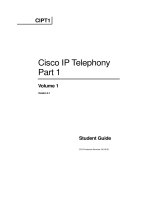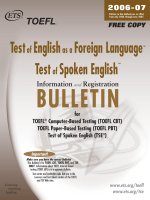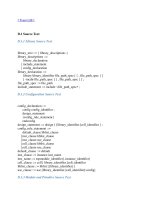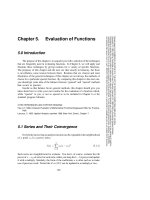Tài liệu IELTS sure success part 1 doc
Bạn đang xem bản rút gọn của tài liệu. Xem và tải ngay bản đầy đủ của tài liệu tại đây (956.49 KB, 15 trang )
www.just2download.blogspot.com
www.just2download.blogspot.com
www.just2download.blogspot.com
www.just2download.blogspot.com
ii
Copyright © 2003 by Linguistics at Nicon. You have been licensed one copy of this document for personal use only. Any
other reproduction or redistribution is strictly prohibited. All rights reserved.
From the Authors: Khurram Kayani & Asad Kayani
Dear future IELTS Success Story:
Congratulations on your purchase of the most advanced test-taking manual
for the IELTS. Notice we did not say study guide- there are plenty of decent
study guides on the market, but that was not our objective in writing this
manual. Our goal is to seek and exploit specific weaknesses in the IELTS
assessment, and then share those secrets with our customers.
Let’s be perfectly honest here- you’ve worked hard enough in the past, and if
you want to spend hours in a study guide to boost your score, that’s a great
thing to do. In fact, we recommend at least a brief review of some of the
better study guides on the market. But that’s simply not enough to do well in
the high-pressure high-stakes environment of the test day. How well you do
on this test will have a significant impact on your future- and we have the
research and practical advice to help you execute on test day.
The product you’re reading now is much more than a study guide- it is a
tactical weapon designed to exploit weaknesses in the test itself, and help
you avoid the most common errors students make when taking the IELTS.
How to use this manual
We don’t want to waste your time. This manual is fast-paced and fluff-free.
We suggest going through it a number of times, trying out its methods on a
number of official practice tests.
First, read through the manual completely to get a feel for the content and
organization. Read the general success strategies first, and then proceed to
www.just2download.blogspot.com
www.just2download.blogspot.com
iii
Copyright © 2003 by Linguistics at Nicon. You have been licensed one copy of this document for personal use only. Any
other reproduction or redistribution is strictly prohibited. All rights reserved.
the individual test sections. Each tip has been carefully selected for its
effectiveness.
Second, read through the manual again, and take notes in the margins and
highlight those sections where you may have a particular weakness (we
strongly suggest printing the manual out on a high-quality printer).
Third, go through at least one official practice test with the manual at your
side and apply the strategies. We believe three practice tests to be the
maximum benefit, the first time with all strategies except time (take as much
time as you need), the second time with all strategies and time constraints,
and a third time without the benefit of the open manual to refer to during the
test. See the appendix for the exclusive list of practice test sources we
believe to be valuable. Quick tip- there is no greater waste of time than
studying practice tests written by anyone other than IELTS.
Finally, bring the manual with you on test day and study it before the exam
begins.
Your success is our success
We would be delighted to hear your IELTS Success Story. Drop us a line at
and tell us your story. Thanks for your
turst on Nicon & Linguistics and we wish you continued success-
Sincerely,
Authors & The IELTS Secrets Team at Linguistics at Nicon.
www.just2download.blogspot.com
www.just2download.blogspot.com
i
v
Copyright © 2003 by Linguistics at Nicon. You have been licensed one copy of this document for personal use only. Any
other reproduction or redistribution is strictly prohibited. All rights reserved.
TABLE OF CONTENTS
SECRET KEY #1 – TIME IS YOUR GREATEST ENEMY. 1
SUCCESS STRATEGY #1 2
Pace Yourself 2
Scanning 3
SECRET KEY #2 – GUESSING IS NOT GUESSWORK 4
MONKEYS TAKE THE IELTS 4
SUCCESS STRATEGY #2 5
SPECIFIC GUESSING TECHNIQUES 7
Slang 7
Extreme Statements 7
Similar Answer Choices 7
Hedging 8
SUMMARY OF GUESSING TECHNIQUES 8
SECRET KEY #3 – PRACTICE SMARTER, NOT HARDER 9
SUCCESS STRATEGY #3 9
SECRET KEY #4 – PREPARE, DON’T PROCRASTINATE 11
THE LISTENING MODULE 12
Main Ideas 12
Voice Changes 12
Specifics 13
Interpret 13
Find the Hidden Meaning 13
Memory Enhancers 14
THE READING MODULE 16
SKIMMING 16
PARAGRAPH FOCUS 18
ELIMINATE CHOICES 19
CONTEXTUAL CLUES 20
FACT/OPINION 20
Opposites 21
Make Predictions 22
Answer the Question 22
www.just2download.blogspot.com
www.just2download.blogspot.com
v
Copyright © 2003 by Linguistics at Nicon. You have been licensed one copy of this document for personal use only. Any
other reproduction or redistribution is strictly prohibited. All rights reserved.
Benchmark 22
New Information 23
Key Words 23
Valid Information 24
TIME MANAGEMENT 24
FINAL WARNINGS 24
Hedge Phrases Revisited 24
Word Usage Questions 25
Switchback Words 25
Avoid “Fact Traps” 26
THE WRITING MODULE 27
Brainstorm 27
Strength through Diversity 27
Pick a Main Idea 28
Weed the Garden 28
Create a Logical Flow 29
Start Your Engines 29
Don’t Panic 30
Check Your Work 31
Shortcut Keys 32
FINAL NOTE 32
THE SPEAKING MODULE 34
Part 1 34
Part 2 34
Part 3 34
Exhausting the Possibilities 35
Tell a Story 35
One Size Fits All 36
Find the Bridges 37
Pregnant Pause 38
Taking the Final Step 38
Practice Makes Perfect 39
SPECIAL REPORT: HOW YOUR IELTS SCORE IS VIEWED, AND WHAT THIS MEANS FOR
YOU 40
SPECIAL REPORT: WHAT JOBS REQUIRE WHICH IELTS SCORES 41
www.just2download.blogspot.com
www.just2download.blogspot.com
vi
Copyright © 2003 by Linguistics at Nicon. You have been licensed one copy of this document for personal use only. Any
other reproduction or redistribution is strictly prohibited. All rights reserved.
SPECIAL REPORT: WHICH IELTS STUDY GUIDES AND PRACTICE TESTS ARE WORTH
YOUR TIME 42
PRACTICE TESTS 42
STUDY GUIDE 42
APPENDIX: COMMON IDIOMS AND EXPRESSIONS 43
www.just2download.blogspot.com
www.just2download.blogspot.com
1
Copyright © 2003 by Linguistics at Nicon. You have been licensed one copy of this document for personal use only. Any
other reproduction or redistribution is strictly prohibited. All rights reserved.
Secret Key #1 – Time is your greatest enemy.
To succeed on the IELTS, you must use your time wisely. Many students do not
finish at least one module. The table below shows the time challenge you are
faced with:
Module Total amount
of time allotted
Number of
questions
Time to answer
each question
Listening 30 min 40 1.34 min
Reading 60 min 40 .67 min
Writing 60 min 2 30 min
Speaking 11-14 min N/A N/A
As you can see, the time constraints are brutal. To succeed, you must ration
your time properly. The reason that time is so critical is that every question
counts the same toward your final score. If you run out of time on any passage,
the questions that you do not answer will hurt your score far more than earlier
questions that you spent extra time on and feel certain are correct.
On the Reading Module, the test is separated into passages. The reason that
time is so critical is that 1) every question counts the same toward your final
score, and 2) the passages are not in order of difficulty. If you have to rush
during the last passage, then you will miss out on answering easier questions
correctly. It is natural to want to pause and figure out the hardest questions, but
you must resist the temptation and move quickly.
www.just2download.blogspot.com
www.just2download.blogspot.com
2
Copyright © 2003 by Linguistics at Nicon. You have been licensed one copy of this document for personal use only. Any
other reproduction or redistribution is strictly prohibited. All rights reserved.
Success Strategy #1
Pace Yourself
Wear a watch to the IELTS Test. At the beginning of the test, check the time (or
start a chronometer on your watch to count the minutes), and check the time
after each passage or every few questions to make sure you are “on schedule.”
Remember that on the Listening and Reading Modules you have a little over half
a minute for each question. If you can work quickly, you can pace yourself at half
a minute per question, which makes it easy to keep track of your time.
If you find that you are falling behind time during the test, you must speed up.
Even though a rushed answer is more likely to be incorrect, it is better to miss a
couple of questions by being rushed, than to completely miss later questions by
not having enough time. It is better to end with more time than you need than to
run out of time.
If you are forced to speed up, do it efficiently. Usually one or more answer
choices can be eliminated without too much difficulty. Above all, don’t panic.
Don’t speed up and just begin guessing at random choices. By pacing yourself,
and continually monitoring your progress against the clock or your watch, you will
always know exactly how far ahead or behind you are with your available time. If
you find that you are a few minutes behind on a module, don’t skip questions
without spending any time on it, just to catch back up. Spend perhaps a little less
than half a minute per question and after a few questions, you will have caught
back up more gradually. Once you catch back up, you can continue working each
problem at your normal pace. If you have time at the end, go back then and finish
the questions that you left behind.
Furthermore, don’t dwell on the problems that you were rushed on. If a problem
was taking up too much time and you made a hurried guess, it must have been
www.just2download.blogspot.com
www.just2download.blogspot.com
3
Copyright © 2003 by Linguistics at Nicon. You have been licensed one copy of this document for personal use only. Any
other reproduction or redistribution is strictly prohibited. All rights reserved.
difficult. The difficult questions are the ones you are most likely to miss anyway,
so it isn’t a big loss. If you have time left over, as you review the skipped
questions, start at the earliest skipped question, spend at most another half a
minute, and then move on to the next skipped question.
Lastly, sometimes it is beneficial to slow down if you are constantly getting ahead
of time. You are always more likely to catch a careless mistake by working more
slowly than quickly, and among very high-scoring test takers (those who are
likely to have lots of time left over), careless errors affect the score more than
mastery of material.
Scanning
For Reading passages, don’t waste time reading, enjoying, and completely
understanding the passage. Simply scan the passage to get a rough idea of
what it is about. You will return to the passage for each question, so there is no
need to memorize it. Only spend as much time scanning as is necessary to get a
vague impression of its overall subject content.
www.just2download.blogspot.com
www.just2download.blogspot.com
4
Copyright © 2003 by Linguistics at Nicon. You have been licensed one copy of this document for personal use only. Any
other reproduction or redistribution is strictly prohibited. All rights reserved.
Secret Key #2 – Guessing is not guesswork.
You probably know that guessing is a good idea on the IELTS- unlike other
standardized tests, there is no penalty for getting a wrong answer. Even if you
have no idea about a question, you still have a 20-25% chance of getting it right.
Most students do not understand the impact that proper guessing can have on
their score. Unless you score extremely high, guessing will significantly
contribute to your final score.
Monkeys Take the IELTS
What most students don’t realize is that to insure that 20-25% chance, you have
to guess randomly. If you put 20 monkeys in a room to take the IELTS,
assuming they answered once per question and behaved themselves, on
average they would get 20-25% of the questions correct on a five choice multiple
choice problem. Put 20 students in the room, and the average will be much
lower among guessed questions. Why?
1. IELTS intentionally writes deceptive answer choices that “look” right. A
student has no idea about a question, so picks the “best looking” answer,
which is often wrong. The monkey has no idea what looks good and what
doesn’t, so will consistently be lucky about 20-25% of the time.
2. Students will eliminate answer choices from the guessing pool based on a
hunch or intuition. Simple but correct answers often get excluded, leaving a
0% chance of being correct. The monkey has no clue, and often gets lucky
with the best choice.
This is why the process of elimination endorsed by most test courses is flawed
and detrimental to your performance- students don’t guess, they make an
ignorant stab in the dark that is usually worse than random.
www.just2download.blogspot.com
www.just2download.blogspot.com
5
Copyright © 2003 by Linguistics at Nicon. You have been licensed one copy of this document for personal use only. Any
other reproduction or redistribution is strictly prohibited. All rights reserved.
Success Strategy #2
Let me introduce one of the most valuable ideas of this course- the $5 challenge:
You only mark your “best guess” if you are willing to bet $5 on it.
You only eliminate choices from guessing if you are willing to bet $5 on it.
Why $5? Five dollars is an amount of money that is small yet not insignificant,
and can really add up fast (20 questions could cost you $100). Likewise, each
answer choice on one question of the IELTS will have a small impact on your
overall score, but it can really add up to a lot of points in the end.
The process of elimination IS valuable. The following shows your chance of
guessing it right:
If you eliminate this many choices on a
3 choice multiple choice problem:
0 1 2
Chance of getting it correct 33% 50% 100%
However, if you accidentally eliminate the right answer or go on a hunch for an
incorrect answer, your chances drop dramatically: to 0%. By guessing among all
the answer choices, you are GUARANTEED to have a shot at the right answer.
That’s why the $5 test is so valuable- if you give up the advantage and safety of
a pure guess, it had better be worth the risk.
What we still haven’t covered is how to be sure that whatever guess you make is
truly random. Here’s the easiest way:
Always pick the first answer choice among those remaining.
Such a technique means that you have decided, before you see a single test
question, exactly how you are going to guess- and since the order of choices
www.just2download.blogspot.com
www.just2download.blogspot.com
6
Copyright © 2003 by Linguistics at Nicon. You have been licensed one copy of this document for personal use only. Any
other reproduction or redistribution is strictly prohibited. All rights reserved.
tells you nothing about which one is correct, this guessing technique is perfectly
random.
Let’s try an example-
A student encounters the following problem on the Listening Module in a
conversation about the chemical term “amine,” a derivative of ammonia:
In the reaction, the amine will be?
A. neutralized
B. protonated
C. deprotonated
The student has a small idea about this question- he is pretty sure that the amine
will be deprotonated, but he wouldn’t bet $5 on it. He knows that the amine is
either protonated or deprotoned, so he is willing to bet $5 on choice A not being
correct. Now he is down to B and C. At this point, he guesses B, since B is the
first choice remaining.
The student is correct by choosing B, since the amine will be protonated. He
only eliminated those choices he was willing to bet money on, AND he did not let
his stale memories (often things not known definitely will get mixed up in the
exact opposite arrangement in one’s head) about protonation and deprotonation
influence his guess. He blindly chose the first remaining choice, and was
rewarded with the fruits of a random guess.
This section is not meant to scare you away from making educated guesses or
eliminating choices- you just need to define when a choice is worth eliminating.
The $5 test, along with a pre-defined random guessing strategy, is the best way
to make sure you reap all of the benefits of guessing.
www.just2download.blogspot.com
www.just2download.blogspot.com
7
Copyright © 2003 by Linguistics at Nicon. You have been licensed one copy of this document for personal use only. Any
other reproduction or redistribution is strictly prohibited. All rights reserved.
Specific Guessing Techniques
Slang
Scientific sounding answers are better than slang ones. In the answer choices
below, choice B is much less scientific and is incorrect, while choice A is a
scientific analytical choice and is correct.
Example:
A.) To compare the outcomes of the two different kinds of treatment.
B.) Because some subjects insisted on getting one or the other of the treatments.
Extreme Statements
Avoid wild answers that throw out highly controversial ideas that are proclaimed
as established fact. Choice A is a radical idea and is incorrect. Choice B is a
calm rational statement. Notice that Choice B does not make a definitive,
uncompromising stance, using a hedge word “if” to provide wiggle room.
Example:
A.) Bypass surgery should be discontinued completely.
B.) Medication should be used instead of surgery for patients who have not had a
heart attack if they suffer from mild chest pain and mild coronary artery blockage.
Similar Answer Choices
When you have two answer choices that are direct opposites, one of them is
usually the correct answer.
Example:
A.) described the author’s reasoning about the influence of his childhood on his
adult life.
B.) described the author’s reasoning about the influence of his parents on his
adult life.
www.just2download.blogspot.com
www.just2download.blogspot.com
8
Copyright © 2003 by Linguistics at Nicon. You have been licensed one copy of this document for personal use only. Any
other reproduction or redistribution is strictly prohibited. All rights reserved.
These two answer choices are very similar and fall into the same family of
answer choices. A family of answer choices is when two or three answer choices
are very similar. Often two will be opposites and one may show an equality.
Example:
A.) Plan I or Plan II can be conducted at equal cost
B.) Plan I would be less expensive than Plan II
C.) Plan II would be less expensive than Plan I
D.) Neither Plan I nor Plan II would be effective
Note how the first three choices are all related. They all ask about a cost
comparison. Beware of immediately recognizing choices B and C as opposites
and choosing one of those two. Choice A is in the same family of questions and
should be considered as well. However, choice D is not in the same family of
questions. It has nothing to do with cost and can be discounted in most cases.
Hedging
When asked for a conclusion that may be drawn, look for critical “hedge”
phrases, such as likely, may, can, will often, sometimes, etc, often, almost,
mostly, usually, generally, rarely, sometimes. Question writers insert these
hedge phrases to cover every possibility. Often an answer will be wrong simply
because it leaves no room for exception. Avoid answer choices that have
definitive words like “exactly,” and “always”.
Summary of Guessing Techniques
1. Eliminate as many choices as you can by using the $5 test. Use the common
guessing strategies to help in the elimination process, but only eliminate
choices that pass the $5 test.
2. Among the remaining choices, only pick your “best guess” if it passes the $5
test.
3. Otherwise, guess randomly by picking the first remaining choice.
www.just2download.blogspot.com
www.just2download.blogspot.com









